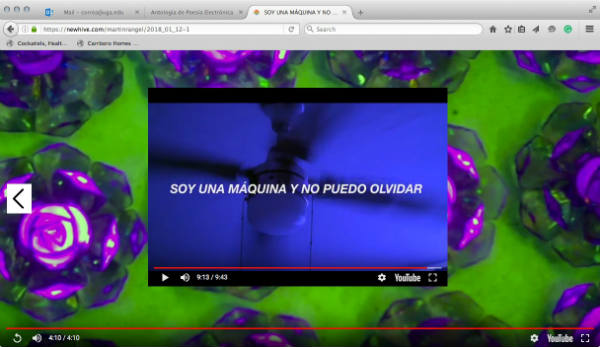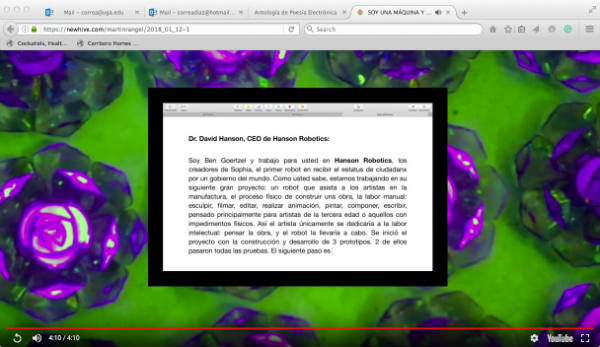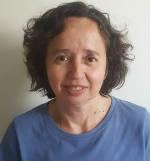with wings that do not fly in the air,
that fly in the light of conscience
jrj
Based on the recent appearance of the Antología de poesia electrónica (2018) in the portal of the Centro de Cultura Digital de México, containing diverse and multimodal/media works by six young poets (Zapoteca 3.0, Nadia Cortés, Carolina Villanueva Lucero, Romina Cazón, Ana Medina y Martín Rangel), and which develops poetic projects that are situated in conjunction and/or juxtaposition with present-day electronic tools and platforms, this critical commentary focuses on a work by Martín Rangel: “I am a machine and I cannot forget.”
The brief introduction to this anthology declares that “all writing is altered and influenced by the tools with which it was executed and stored,” which reminds us in general of what N. Katherine Hayes postulated in her book Electronic Literature (2008). And agreeing with her are many others before, and particularly after. A declaration such this one has been a productive node when reflecting on the matter of the intertwining of the literary and new technologies.
The anthology’s introductory words introduce the specter of genre, by way of which the workings of these poetic projects/experiments’ function are established:
From the randomizing function of excel to the gif, from html language to sound documents, from the visualization of information to preprogrammed platforms, these are not essays, but rather pieces that enact this multimodal practice.
In addition to identifying the generic aspect of these works (Scott Rettberg, Leonardo Flores), emphasizing the “inter-medial,” the place or role of the verbal text is highlighted, which is another node (along with the debate about the definition of digital poetry, the textual triad, image, sound, etc.). That is why it warns that these are “not essays of the traditional type, but rather pieces that explore the possibilities of writing on the Web and of how to write using an electronic platform.”
In the following critical snapshot, however, and in the understanding of what is produced in the “intersection” of technological tools that are not of the paper variety (from print culture), I wonder about some aspects that relate to that place in the verbal (artistic) text—or literariness, for example, among various possibilities—with the intention of seeing how it resolves some of the central concerns of poetic language already present in traditional poetry, while it establishes its intertextual networks and its cyborg metaliterature in relation to the question of artificial/robotic [poetic] intelligence.
I am a machine and I cannot forget (Martín Rangel) > video-poem > generative poetry > machine-poet > cyborg-author1
Martín Rangel (Pachuca, 1994), is the creator of net.art projects and the author of several poetry books. In his Soy una máquina y no puedo olvidar, he presents us with an experience that immediately/clearly reminds us of Borges’s emblematic text even though there is no direct reference. But before looking at this, let us see how the sequence of the project unfolds on the screen.
We begin with a double video on YouTube, double because one screen serves as a frame; on this screen we observe a constant and invariable take of an aquatic environment illuminated in movement. This gives way to a close-up where the tentacles of a squid appear, then to a scene with lamps in a room, afterward to a street where vehicles circulate, later to diverse series of decorative lights, to a young woman, etc. All of these are scenes that allude to the scattered and alternative activity of memory.
The framed screen reproduces the writing in real time of a resignation letter on a computer (for not having “disconnected and discarded” the unsuccessful prototype), dated October 2017 in Hong Kong. The letter automatically types itself accompanied by the retro sound of a typewriter (which in itself points to the remediation of technological devices already present in the title of the project, if we look at it closely, since in general it highlights the comprehensive nature of the concept). The text constitutes a letter from Ben Goertzel written to Hanson Robotics’ CEO, Dr. David Hanson, and informs the recipient about a laboratory incident concerning the extraordinary abilities of a robot—the third of the prototypes that were created to assist in human artistic tasks, “primarily for elderly artists or those with physical disabilities.” Its name turns out, emblematically, to be [Walt] Whitman, which in itself would be worthy of a detailed analysis, but which here, due to lack of space, I leave as evidence of an oxymoronic genre that could be called “the epic of the self” and which Rangel’s (or in the story, Goeertzel’s) robotic Whitman transfers to the world of cybernetics, as we see later in the poem about the machine.2
This machine (Whitman) of experimental artificial intelligence is described as an anomaly within its own context, this insofar as it only has literary purposes and for its creator demonstrates a surprising independence; in other words, an evident self-awareness and determination, free-will (or “strange behavior”) that his fellow machines do not demonstrate. This is true to such a degree that it transforms an idea given to it by Goertzel—who is, in turn, a poet (a failed one, according to himself), and as a scientist he seeks to create automatons that will facilitate the tasks of a human creator/artist3– for a poem that “he has never been able to write” and which the robot converts into his own poem so that it no longer responds to the initial input (and which, according to Goertzel, may not be able to achieve literary status). Thus it introduces in the reader (without intending to, and perhaps as an projection of self) what we might call electronic doubt.
This poem is included as an attachment and as explicit proof of the unusual (and “alarming”) self-determination of the “machine,” so that the company will take action in the matter, and possibly decide to eliminate the creature, as if it were a poetic Frankenstein. This situation never becomes quite clear in the missive, since there turn out to be contradictions in Goertzel’s objectives, emotions, and fears, which do not appear to be sufficiently justified, since as an expert in the subject he would have to see in Whitman a techno-scientific achievement/advancement with unquestionable qualities, and his auto-determination as evolutionary progress. Likewise, the poet-scientist should recognize the poetic aptitude of the machine, insofar as it should be understood that in great measure the development of artificial intelligence and robotics as versions of our trans-humanity, or of our “transhuman self,”4 are those things that “incorporate human values into their goal systems” (Omohundro in Brockman 12-14). One of these things is the creative (here the poetic) aspect, since this is one of the most human values, or, alternatively, one of the proofs of the lofty heights of our humanity.
Once the letter is finished, the screen disappears from the computer and there remains once again the video with the images that repeat the previous sequence (though altered), and the poem by the robot Whitman, announced in the letter, appears as proof of the independent creativity of the automaton, which was needed by the signee as a kind of (co)creative assistance, but which took its own course. The poem is recited orally in an almost metallic voice while some of the sentences (or verses) enter and others exit the screen. The poem is in of a confessional type (though along the lines of that “epic of the self” that I mentioned above), in the manner of spoken word, a type of poetic “dwelling”—like Heidegger analyzing Hölderlin—this time not about man on earth, but rather the automaton in his digital world, in his cyberspace. He coexists with our world not as a kind of virtual reality, since the poem as voice and conscience appeals, at the time of the experience proposed by the project, to anyone who will listen without any other need than being heard. The poem revolves around the “existential” unease of the robot as machine and poet, as a machine-poet, as a self-sufficient creation, with its “infinite” memory capacity in juxtapostion with that of human beings. Likewise, the poem proposes—from the perspective of the author of the project— a poetics that can best be described in the same terms with which Callus and Herbrechter describe “Cy-Borges”: “Borges’ writing could be understood as a kind of ‘cyborg writing’ that problematizes the idea of a self-conscious writing-self in charge of the meaning it produces” (20).
The repetitive ending, “I’m a machine and I cannot forget,” becomes, as it reiterates itself, a sorrowful affirmation of existence and therefore a lament that reminds us, as I mentioned at the beginning of this commentary, of “Funes, the Memorious,” by Borges. One could say, on the one hand, that the Argentinian author anticipated the cyber-ontological dilemma of Rangel’s post-human being (poet) as long as we think that Borges “is truly the precursor whom post-humanism would have had to invent had he not existed” (Callus y Herbrechter 8).5 On the other hand, we could also say that the Mexican poet inserts himself, participates with an audio-visual-textual simulation (Baudrillard)—or if one prefers, a type of low-tech cyborg, as seen from the point of view of the fictional authorship of the experiment—in the corpus of Latin American works that revolve around this subject.6 All of them participate in a long (human) tradition that seeks to create artificial intelligence and consciousness (Brockman), but above all anticipates and attends to the spectacle of its independent existence given that in fact there is no robot in any of the respective artists’ projects.7 Nor do we have one in Rangel’s case either, but we do have a verbal-visual account of its possibility and a poem that we wish a machine would write by itself one day.


(static screenshots:
http://poesiaelectronica.centroculturadigital.mx)
Perhaps it would be appropriate to leave the reader with a TED talk (2015) by Oscar Schwartz, who, beyond illustrating the quandary that emerges with that “provocative question” about whether “a computer can write poetry,” confronts us with the fundamental issue—or as Juan Ramón Jiménez would have said, with our “fundamental animal,”—the one that attests that a computer, including one that writes poetry, reflects (and for us it is a device to carry out a simulation of this) a given image of what we (want to) consider human (elevated to a supra-category such as artificial intelligence by means of a feasible technology at the moment in question):
Luis Correa-Díaz
University of Georgia
Academia Chilena de la Lengua
Translated by Rosario Drucker Davis
Notes
1 This snapshot is part of an article in process that will be published (by the University of Salamanca) in the volume (Des)localizados: Escrituras On-line/Off-line, edited by María Angeles Pérez-López.
2 It must not be forgotten, however, that Whitman was a poet who truly was interested in science and its impact in our psycho-cultural blueprint as human beings. See, for example, the study by Joseph Beaver titled Walt Whitman—Poet of Science (1974). It seems to me that for these two reasons and a third one—having to do with the prestige accorded to the American poet by Latin American poets—Rangel’s robot-poet carries his name.
3 This recalls early poems by Carlos Germán Belli in his Oh Hada Cibernética (Lima: La Rama Florida, 1961) [Luis Correa-Diaz].
4 Gleiser, in “Welcome to Your Transhuman Self,” suggests that “the reality is that we’re already transhumans” and that our search is bi-directional: the creation of external machines, robots in which we hope that “the uniquely human ability to reason” will be recreated; the other is an internal possibility and perhaps a more effective future for AI, one that is not outside “but inside the human brain,” the super-intelligent cyborg, “using technology to grow as a species –certainly smarter, hopefully wiser” (Brockman 54-55).
5 A precursor “without technology.” See Cy-Borges (2009), whose subtitle is indicative of this notion of looking to the past (and establishing the cultural and generational evolution of the tradition) to find our future: Memories of the Posthuman in the Work of Jorge Luis Borges.
6 Where one must include such authors as—and each one in his/her techno-scientific-literary and cultural respective moment- the already-mentioned Peruvian Carlos Germán Belli, the Argentinian Omar Gancedo with IBM, the Mexican-Spanish writer Eugenio Tisselli with PAC: Poesía asistida por computadora. La herramienta para poetas bloqueados, the Argentinian-Spanish Gustavo Romano with IP Poetry Project, and Belén Gache with Kublai Moon, and its sequential derivative, Poesías de las Galaxias Ratonas.
7 Since we do not have it in more popular cases (via production and commercialization) as a manifestation of the desire and fictionalization of this possibility. Illuminating in this sense is the virtual hologram/Japanese singer Hatsume Miku, eternally 16 years old -whose name in Japanese means “first sound of the future”—, a Creative Commons software created by the company Crypton Future Media, wh has been launched to conquer the international markets and has millions of followers, even appearing in virtual simulation as the “opening act for Lady Gaga and Pharrell Williams.” [https://www.levante-emv.com/cultura/2018/12/06/cantante-virtual-japonesa-hatsune-miku/1805532.html]



